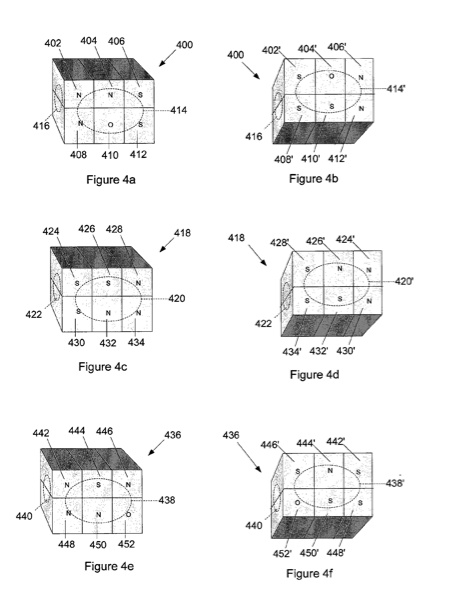An Apple patent (20120032765) for magnetic fasteners has appeared at the U.S. Patent & Trademark Office. The various embodiments described in the patent generally relate to magnetic fasteners.
More particularly, the various embodiments described relate to apparatus, methods and systems for utilizing programmable magnetic devices to fasten, or unfasten, two or more components or devices. The inventors are Brett Bilbrey, Aleskandar Pance, Peter Arnold, David L. Simon, Jean lee, Michael D. Hillman, Gregory L. Tice, Vijay Iyver and Bradley Spare.
Here’s Apple’s background and summary of the invention: “Traditionally, various mechanical types of fasteners have been utilized to facilitate a permanent, semi-permanent or temporary coupling of the two or more devices. Examples of devices utilized to accomplish such coupling include screws, rivets, nails, bolts and nuts, non-programmable magnets, tape, wire binding, soldering, and other fastening devices and techniques.
“While such fasteners and techniques may provide for the desired coupling, they commonly and collectively suffer from the inability to selectably determine which two or more devices are too be coupled. Further, such fastening devices and techniques often are deficient in that the ability to provide a strong coupling also is commonly presented with an inability or greater difficulty in removing such coupling at a later time. As such a need exists for fastening devices, systems, techniques, and tools for the same which enable selective coupling at a desired retention and/or attractive strength while also facilitating a ready disengagement of such coupled items at a desired time.
“These and other limitations of existing apparatus, methods, and systems for fastening two or more devices are overcome by the various embodiments described herein. In at least one first embodiment, a fastening device is provided which includes a first structure comprising at least a first maxel and a second maxel.
“Each of the first maxel and the second maxel may have a polarity and a magnetic strength. A second structure is also provided which may include at least one third maxel and at least one fourth maxel. Each of the third maxel and the fourth maxel may also have a polarity and a magnetic strength. The polarity of the first maxel, the second maxel, the third maxel and the fourth maxel may be configured to fasten the first structure to the second structure by developing magnetic attractions between one or more of the maxels on the first structure with one or more of the maxels on the second structure, for example, the first maxel with the third maxel and/or the second maxel with the fourth maxel.
“In at least one second embodiment, a correlated magnetic structure is provided which may have two or more maxels. Either of such maxels may be configured as an electromagnetic structure which allows for programmability in desirably magnetic polarity and/or magnetic field strength. Such programmability may be obtained, for example, by inducing a the current in a first direction such that a first polarity, creating an attractive force, is created in one of the maxels and by reversing the current into a second direction such that a second polarity is created in one more maxels which results in a repulsive force arising between some or all of the first structure with respect to the second structure.
“In at least one third embodiment, a method for fastening a first structure to a second structure is provided. According to this method, each of the first structure and the second structure have at least one magnetic property. Further, the second structure may include a programmable correlated magnetic structure having two or more maxels. The method entails the operations, in any sequence, of determining at least one magnetic property of the first structure; and configuring the magnetic polarity of a first maxel of the two or more maxels in the second structure such that upon being so configured the magnetic polarity of the first maxel creates an attractive magnetic force with the first structure.
“Additional features and advantages of the before mentioned and other embodiments will be set forth in the description which follows, and in part will be obvious from the description, or may be learned by the practice of the embodiment(s). The features and advantages of one or more of the various embodiments may be realize and/or obtained by use and/or practice of the instruments, combinations, systems, operations and/or methodologies particularly pointed out in the appended claims and/or in any future arising claim in this or a related application. These and other features of the various embodiments will become more fully apparent from the following description and appended claims, or may be learned by practice of one or more embodiments as set forth hereinafter.”


